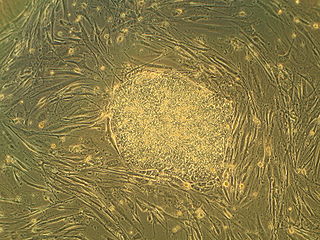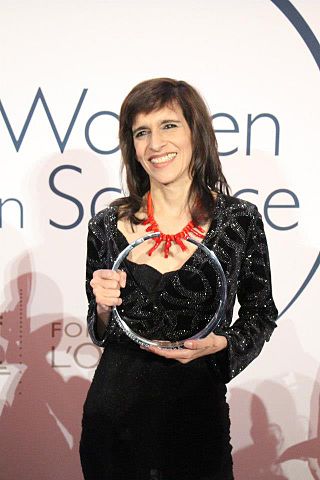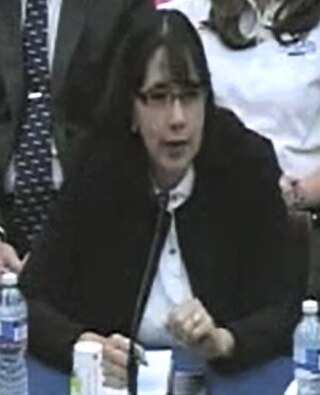
The Federal University of Rio Grande do Sul is a Brazilian public federal research university based in Porto Alegre, Rio Grande do Sul. UFRGS is among the largest and highest-rated universities in Brazil, having one of the largest number of scientific publications. From 2012 to 2019, the university was elected as the best federal university of Brazil. UFRGS has over 31,000 undergraduate students, over 12,000 graduate students, and more than 2,600 faculty members. As a Brazilian public federal institution, students do not pay tuition fees to enroll in courses offered by the university.

Regenerative medicine deals with the "process of replacing, engineering or regenerating human or animal cells, tissues or organs to restore or establish normal function". This field holds the promise of engineering damaged tissues and organs by stimulating the body's own repair mechanisms to functionally heal previously irreparable tissues or organs.

Nanofibers are fibers with diameters in the nanometer range. Nanofibers can be generated from different polymers and hence have different physical properties and application potentials. Examples of natural polymers include collagen, cellulose, silk fibroin, keratin, gelatin and polysaccharides such as chitosan and alginate. Examples of synthetic polymers include poly(lactic acid) (PLA), polycaprolactone (PCL), polyurethane (PU), poly(lactic-co-glycolic acid) (PLGA), poly(3-hydroxybutyrate-co-3-hydroxyvalerate) (PHBV), and poly(ethylene-co-vinylacetate) (PEVA). Polymer chains are connected via covalent bonds. The diameters of nanofibers depend on the type of polymer used and the method of production. All polymer nanofibers are unique for their large surface area-to-volume ratio, high porosity, appreciable mechanical strength, and flexibility in functionalization compared to their microfiber counterparts.
Impalefection is a method of gene delivery using nanomaterials, such as carbon nanofibers, carbon nanotubes, nanowires. Needle-like nanostructures are synthesized perpendicular to the surface of a substrate. Plasmid DNA containing the gene, and intended for intracellular delivery, is attached to the nanostructure surface. A chip with arrays of these needles is then pressed against cells or tissue. Cells that are impaled by nanostructures can express the delivered gene(s).

Anthony Atala is an American bioengineer, urologist, and pediatric surgeon. He is the W.H. Boyce professor of urology, the founding director of the Wake Forest Institute for Regenerative Medicine, and the chair of the Department of Urology at Wake Forest School of Medicine in North Carolina. His work focuses on the science of regenerative medicine: "a practice that aims to refurbish diseased or damaged tissue using the body's own healthy cells".
Nano-scaffolding or nanoscaffolding is a medical process used to regrow tissue and bone, including limbs and organs. The nano-scaffold is a three-dimensional structure composed of polymer fibers very small that are scaled from a Nanometer scale. Developed by the American military, the medical technology uses a microscopic apparatus made of fine polymer fibers called a scaffold. Damaged cells grip to the scaffold and begin to rebuild missing bone and tissue through tiny holes in the scaffold. As tissue grows, the scaffold is absorbed into the body and disappears completely.
Nick Rhodes is a Reader in Tissue Engineering and Regenerative Medicine at the University of Liverpool, in the U.K. Tissue Engineering can be described as the use of engineering techniques, including engineering materials and processes, in order to grow living tissues. Regenerative Medicine can be described as the treatment of defective tissues using the regenerative capacity of the body's healthy tissues. Rhodes describes the discipline as "aiming to repair tissue defects by driving regeneration of healthy tissues using engineered materials and processes."

Márcia Cristina Bernardes Barbosa is a Brazilian physicist known for her research on the properties of water, and for her efforts for improving the conditions for women in academia. She is a professor at UFRGS, and a director of the Brazilian Academy of Sciences. She is the elected rector of UFRGS.

Gordana Vunjak-NovakovicFRSC is a Serbian American biomedical engineer and university professor. She is a University Professor at Columbia University, as well as the Mikati Foundation Professor of Biomedical Engineering and Medical Sciences. She also heads the laboratory for Stem Cells and Tissue Engineering at Columbia University. She is part of the faculty at the Irving Comprehensive Cancer Center and the Center for Human Development, both found at Columbia University. She is also an honorary professor at the Faculty of Technology and Metallurgy at the University of Belgrade, an honorary professor at the University of Novi Sad, and an adjunct professor at the Department of Biomedical Engineering at Tufts University.
José da Costa Sacco was a Brazilian botanist.

Tissue Engineering and Regenerative Medicine International Society is an international learned society dedicated to tissue engineering and regenerative medicine.

Samuel I. Stupp, is a Board of Trustees Professor of Materials Science, Chemistry, and Medicine at Northwestern University in Chicago, IL. He is best known for his work on self-assembling materials and supramolecular chemistry. One of his most notable discoveries is a broad class of peptide amphiphiles that self-assemble into high aspect ratio nanofibers with extensive applications in regenerative medicine. He has also made significant contributions to the fields of supramolecular chemistry, nanotechnology, and organic electronic materials. He has over 500 peer-reviewed publications and was one of the 100 most cited chemists in the 2000–2010 decade.

Rui Luís Reis is a Portuguese scientist known for his research in tissue engineering, regenerative medicine, biomaterials, biomimetics, stem cells, and biodegradable polymers.
Molly S. Shoichet, is a Canadian science professor, specializing in chemistry, biomaterials and biomedical engineering. She was Ontario's first Chief Scientist. Shoichet is a biomedical engineer known for her work in tissue engineering, and is the only person to be a fellow of the three National Academies in Canada.
Nano neuro knitting is an emerging technology for repairing nervous system tissues via nano scaffolding techniques. Currently being explored in numerous research endeavors, nano neuro knitting has been shown to allow partial reinnervation in damaged areas of the nervous system through the interactions between potentially regenerative axons and peptide scaffolds. This interaction has been shown to lead to sufficient axon density renewal to the point that functionality is restored. While nano neuro knitting shows promise, the uncertainty of the effects in human subjects warrants further investigation before clinical trials initiate.
Katja Schenke-Layland is the Professor of Medical Technologies and Regenerative Medicine, Institute of Biomedical Engineering, Department for Medical Technologies and Regenerative Medicine at the University of Tübingen. She is the Director of the NMI Natural and Medical Sciences Institute at the University Tübingen in Reutlingen, Study Dean of Medical Technologies at the University of Tübingen, and Founding Director of the Institute of Biomedical Engineering at the Medical Faculty of the University Tübingen. She is also the Founding Director of the 3R Center for In Vitro Models and Alternatives to Animal Testing Tübingen.
Helen Haiyan Lu is a Chinese American biomedical engineer and the Percy K. and Vida L. W. Hudson professor of biomedical engineering at the Columbia University Fu Foundation School of Engineering and Applied Science. Her work focuses on understanding and developing therapies in complex tissue systems, especially the interface between soft tissue and bone.

Miss Brazil 2009 was the 55th edition of the Miss Brazil pageant. It was held on 9 May 2009 at the Latin American Memorial Complex in São Paulo, São Paulo State, Brazil and was hosted by Nayla Micherif and Renata Fan. Natálya Anderle of Rio Grande do Sul crowned her successor Larissa Costa of Rio Grande do Norte at the end of the event. Costa represented Brazil at the Miss Universe 2009 pageant. 1st Runner-Up, Rayanne Morais of Minas Gerais represented the country at Miss International 2009.

Karen Lozano is a Mexican American researcher who is the Julia Beecherl Endowed Professor of Mechanical Engineering and Director of the Nanotechnology Center at the University of Texas Rio Grande Valley. She studies carbon nanofiber-reinforced thermoplastic composites. She was elected Fellow of the National Academy of Inventors in 2020 and the National Academy of Engineering in 2023.
Joseph Vacanti is an American pediatric surgeon and researcher who is the director of the Laboratory of Tissue Engineering and Organ Fabrication at Massachusetts General Hospital. He is the John Homans Professor of Surgery at Harvard Medical School.











